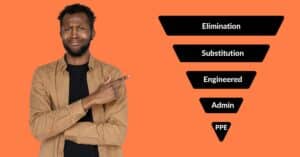Over 2 million UK workers are exposed to noise levels > 85 dB(A) on average during their working day. Not only is it annoying, but loud noises also pose severe health risks.
Over time, exposure to high-decibel noise levels causes permanent hearing loss, tinnitus (ear ringing), and other conditions.
Addressing noise hazards at work is more than just fulfilling legal obligations. More importantly, it shows the employer’s dedication and commitment towards employee welfare. Clear standards for companies to protect their staff from excessive noise exposure are outlined in the Control of Noise at Work Regulations 2005.
To learn how to protect employee hearing and well-being, follow our step-by-step guide for complying with Noise at Work Regulations.
TL;DR – How to Comply with Noise at Work Regulations
The Control of Noise at Work Regulations (2005) promotes a safety culture in the workplace and requires employers to protect employees’ hearing and health. Here are 5 steps to follow to comply with noise-at-work regulations:
- Step 1: Conduct a noise risk assessment to identify sites where exposure levels exceed permissible limits (80 decibels or above).
- Step 2: Put noise-reduction measures in effect. If possible, remove the source, use noise barriers or quieter equipment, and offer Hearing Protection Equipment (HPE) as needed.
- Step 3: Educate workers on the dangers of noise exposure and proper HPE use.
- Step 4: Provide audiometric testing to staff members who frequently work in noisy environments.
- Step 5: Keep track of all noise measurements, risk assessments, control measures, and audiometric testing findings for future reference.
Managing the complexity of workplace noise regulations alone can be risky and exhausting. At TSW Training, we can help educate your staff about the risks of excessive noise exposure, train them to use protective gear in Hearing Protection Zones, and ensure Noise at Work regulations compliance with NEBOSH-approved health and safety courses.
Why is it Important to Control Noise in the Workplace?
Julian Treasure (CEO of The Sound Agency) put it best: “Sound affects us psychologically, cognitively, and behaviorally.”
It’s true; background noise disturbs concentration and information processing and dramatically impacts worker productivity, according to a British Journal of Psychology study.
Further studies indicate a link between workplace noise exposure and a higher likelihood of hypertension, with each 5 dB(A) increase in noise level raising the risk. Exposure to noise levels exceeding 80 dB(A) substantially increases the risk of hypertension. Prolonged exposure (≥85 dB(A)) has been shown to raise both systolic and diastolic blood pressure.
Beyond the well-established risk of hearing loss, excessive noise levels at work also pose a serious hazard to worker safety.
For example, loud background noise can mask crucial safety warnings like fire alarms or machine warnings. The inability to hear these warnings clearly raises the likelihood of accidents and injury.
What are UK Noise Laws Related to the Workplace?
Hearing loss affects one out of every six adults in the United Kingdom. The government has enacted some laws to control excessive noise in the workplace, which are:
Control of Noise at Work Regulations 2005
The Control of Noise at Work Regulations 2005 is the primary legal basis for protecting UK workers against noise-induced hearing loss.
As per these guidelines, employers must analyse noise-related risks, practice control measures that lower noise exposure, and provide hearing protection to their employees (as needed).
Here’s a brief overview of the exposure limit values and action values as per Control of Noise at Work Regulations 2005:
- Lower Exposure Action Value (LEAV): When exposure levels average more than 80 dB(A) for a workday/week, employers are required to inform and train their workers about noise hazards and protective measures.
- Upper Exposure Action Value (UEAV): When the average noise exposure exceeds 85 dB(A), companies must provide hearing protection and designate hearing protection zones.
- Exposure Limit Value (ELV): Even with hearing protection, noise levels above 87 dB(A) are not permitted.
Note that employers violating the specified noise exposure limitations outlined in Control of Noise at Work Regulations 2005 can face serious legal consequences, including fines and perhaps prosecution.
Noise at Work Regulations 1989
The Noise at Work Regulations 1989 paved the way for noise regulation in UK workplaces.
Initial limitations were imposed under these laws, which required hearing protection over 85 dB(A) and an average noise exposure of 90 dB(A) for an 8-hour workday. Employers were also obligated to identify and manage noise hazards.
However, as scientific knowledge of hearing damage and the need for source-based protection grew, stricter regulations were imposed in 2005.
Note that the Noise at Work Regulations 1989 laws are still in effect partially, though superseded by Control of Noise at Work Regulations 2005.
What are Hearing Protection Zones?
The Control of Noise at Work Regulations 2005 requires workplaces to set up designated Hearing Protection Zones.
These zones are the regions where noise levels surpass 85 decibels (dB), commonly recognised as the upper exposure action value. Anyone approaching these areas must wear proper safety equipment to protect their hearing.
What are the Laws on Playing Music in the Workplace?
There are no specific restrictions governing music playback at work (yet). Nevertheless, the Health and Safety at Work Act 1974 remains in effect., and requires employers to ensure a safe working environment.
This includes maintaining reasonable noise levels, including any music being played. In simple terms, the volume should not interfere with important communication or focus, nor should it endanger employee well-being.
How to Comply with the Control of Noise at Work Regulations
Promoting employee well-being and compliance with legal standards go hand in hand.
Here’s a complete summary of the five steps companies should take to comply with the Control of Noise at Work Regulations 2005 law:
Step 1: Risk Assessment & Measurement
The first phase of this two-fold step begins with a risk assessment of the workplace to identify probable sources of excessive noise.
This in-depth analysis accounts for noises made by factory machinery, office equipment, ongoing operations — even employee behaviours that contribute to high noise levels (e.g. loud conversations in open-plan offices).
The second phase is about quantifying noise exposure. At this point, calibrated sound level metres are a necessity. These sensors accurately monitor noise levels across the workplace, providing insightful data about employees’ daily/weekly noise exposure across different areas.
As we’ve previously learned, the Control of Noise at Work Regulations 2005 establishes two noise limits: lower (80 dB(A)) and higher (85 dB(A)) exposure values. By comparing the measured noise levels at their workplace to these set limits, employers can identify areas with possible hearing damage risks and put effective control measures in action.
Step 2: Implementing Control Measures
The Control of Noise at Work Regulations 2005 specifies a multifaceted strategy for implementing control measures to prevent noise hazards at work.
According to the “Hierarchy of Controls” principle, starting with engineering controls is the first step toward noise reduction. As per this rule, employers should actively prioritise steps like enclosing noisy machines, using quieter office equipment, and introducing sound-absorbing materials into the workplace.
However, when total noise cancellation isn’t possible, employers should focus on cutting down on noise transmission. To reduce noise spread, the HSE’s Workplace Design practices suggest building control devices, such as sound barriers or vibration dampeners. Employers can also combat excessive noise by setting and following strict equipment maintenance schedules.
Step 3: Information, Instruction & Training
Employers are legally required to provide extensive information and training on the potential health risks of noise exposure to their workers. This course of action involves:
- Informing people on legal exposure limits
- Instructing on wearing proper Hearing Protection Equipment (HPE)
- Training how to select, use, and maintain these equipment
The 2005 Act also requires companies to actively consult with their workers throughout the noise control process. Because this collaborative approach promotes open communication, they can voice concerns about excessive noise levels and offer out-of-the-box ideas.
On the other hand, employers can promote ownership and responsibility among their employees by including them in decision-making.
Step 4: Health Surveillance
There’s no denying that noise-induced hearing loss should be detected ASAP.
Employers must arrange non-invasive health surveillance programs for workers exposed to noise exceeding the lower exposure action value (80 dB(A)) for an extended time, as mandated by the 2005 act. Here are three reasons why:
- Detecting early signs of noise-induced hearing damage
- Providing the proper treatment to stop further deterioration
- Assessing how well-performing current noise control methods are.
Note that these audiometric testing processes evaluate an individual’s hearing capacity at different frequencies.
Step 5: Record Keeping & Reporting
Companies must keep detailed records about their active noise control measures. When relevant authorities conduct inspections, this data is used as proof of compliance.
To be more specific, employers must keep detailed records of:
- Highest and lowest noise level measurements
- Workplace noise risk assessments
- Control measures taken & HPE supplied over time
- Health surveillance program results
But why is record-keeping important? Because when relevant authorities conduct inspections, this data will be used as proof of compliance.
Tips for Protecting Workers from Noise
Ensuring health and safety in the workplace is every employer’s responsibility, without a doubt.
Yes, fundamental control measures, including (but not limited to) quieter equipment and HPE, are unquestionably effective. But what about those uncommon, frequently overlooked hacks to successfully manage workplace noise pollution?
Here are some additional tips for safeguarding employees from excessive noise:
- Schedule high-noise activities during times when there are fewer people present.
- Limit individual exposure to loud noises by rotating employee shifts regularly.
- Strategic planting helps create a calmer atmosphere for compact offices, as some plants (e.g. Boston Ferns, Peace Lily, Ficus, Begonia Fex) naturally absorb sound.
- While not a perfect replacement for normal HPE, active noise-cancelling headphones can help reduce noise for specialised jobs.
- Use smartphone apps to measure real-time noise levels and perform targeted measures in high-risk areas.
- Promptly address noise complaints; never wait for situations to escalate.
Following these valuable tips, apart from the aforementioned Noise at Work regulations, shows that you’re not afraid to go the extra mile to protect your employees from hearing damage and other health risks.
Frequently Asked Questions (FAQs)
Before we wrap up, let’s look at some FAQs regarding compliance with the Control of Noise at Work Regulations 2005 Law.
How Many Decibels Is Too Loud According to the Regulations?
As per the regulations, noise exposure levels higher than 85 dB(A) are considered “too loud”. Noise levels between 80 dB(A) and 85 dB(A) averaged over an 8-hour workday are permissible in the UK.
At What Decibel is Hearing Protection Required?
Employers must supply Hearing Protection Equipment (HPE) when noise exposure exceeds the upper exposure limit of 85 decibels (dB) averaged over an 8-hour workday.
Note that HPE is not the only answer to excessive noise levels at work. Control methods to lower noise levels at the source should always be the top priority for employers.
What are Noise at Work Action Levels?
The Control of Noise at Work Regulations (2005) set two primary action levels:
- When the Lower Exposure Action Value (LEAV) reaches 80 dB(A), employers must do noise risk assessments, educate employees about the risks, and implement noise reduction measures.
- When the Upper Exposure Value (UEV) reaches 85 dB(A), implement stronger steps like removing the noise source (if possible), adding engineering controls, providing hearing protection, and offering audiometric testing to regularly exposed workers.
Conclusion
By taking proactive steps to address noise problems, employers can show their dedication to creating a safe and healthy work environment. Three reasons why you should start today: lower employee attrition, less absenteeism, and reduced financial burden.
At TSW Training, we offer a comprehensive suite of NEBOSH-accredited health and safety training courses to provide your employees with the information and skills required to control noise-induced hazards at work properly.
Contact us today — we can lead your workers through the noise management process, ensure regulatory compliance, and help create a safer, healthier workplace for everyone.













